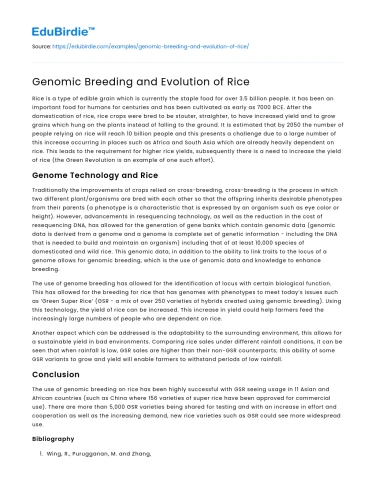Rice is a type of edible grain which is currently the staple food for over 3.5 billion people. It has been an important food for humans for centuries and has been cultivated as early as 7000 BCE. After the domestication of rice, rice crops were bred to be stouter, straighter, to have increased yield and to grow grains which hung on the plants instead of falling to the ground. It is estimated that by 2050 the number of people relying on rice will reach 10 billion people and this presents a challenge due to a large number of this increase occurring in places such as Africa and South Asia which are already heavily dependent on rice. This leads to the requirement for higher rice yields, subsequently there is a need to increase the yield of rice (the Green Revolution is an example of one such effort).
Genome Technology and Rice
Traditionally the improvements of crops relied on cross-breeding, cross-breeding is the process in which two different plant/organisms are bred with each other so that the offspring inherits desirable phenotypes from their parents (a phenotype is a characteristic that is expressed by an organism such as eye color or height). However, advancements in resequencing technology, as well as the reduction in the cost of resequencing DNA, has allowed for the generation of gene banks which contain genomic data (genomic data is derived from a genome and a genome is complete set of genetic information - including the DNA that is needed to build and maintain an organism) including that of at least 10,000 species of domesticated and wild rice. This genomic data, in addition to the ability to link traits to the locus of a genome allows for genomic breeding, which is the use of genomic data and knowledge to enhance breeding.
Save your time!
We can take care of your essay
- Proper editing and formatting
- Free revision, title page, and bibliography
- Flexible prices and money-back guarantee
The use of genome breeding has allowed for the identification of locus with certain biological function. This has allowed for the breeding for rice that has genomes with phenotypes to meet today’s issues such as ‘Green Super Rice’ (GSR - a mix of over 250 varieties of hybrids created using genomic breeding). Using this technology, the yield of rice can be increased. This increase in yield could help farmers feed the increasingly large numbers of people who are dependent on rice.
Another aspect which can be addressed is the adaptability to the surrounding environment, this allows for a sustainable yield in bad environments. Comparing rice sales under different rainfall conditions, it can be seen that when rainfall is low, GSR sales are higher than their non-GSR counterparts; this ability of some GSR variants to grow and yield will enable farmers to withstand periods of low rainfall.
Conclusion
The use of genomic breeding on rice has been highly successful with GSR seeing usage in 11 Asian and African countries (such as China where 156 varieties of super rice have been approved for commercial use). There are more than 5,000 GSR varieties being shared for testing and with an increase in effort and cooperation as well as the increasing demand, new rice varieties such as GSR could see more widespread use.
Bibliography
- Wing, R., Purugganan, M. and Zhang, Q. (2019). The Rice Genome Revolution: From an Ancient Grain to Green Super Rice. [online] nature.com. Available at: https://www.nature.com/articles/s41576-018-0024-z
- Yorobe, Jose & Pede, Valerien & Rejesus, Roderick & Velarde, Orlee & Wang, Huaiyu & Ali, Jauhar. (2014). Yield and Income Effects of the Green Super Rice (GSR) Varieties: Evidence from a Fixed-Effects Model in the Philippines. Avaliable at: https://www.researchgate.net/publication/281374055_Yield_and_Income_Effects_of_the_Green_Super_Rice_GSR_Varieties_Evidence_from_a_Fixed-Effects_Model_in_the_Philippines
- Callaway, E. (2014). Domestication: The Birth of Rice. Nature, 514(7524), pp. S58-S59. Available at: https://www.nature.com/articles/514S58a
- Nature.com. (2019). genome | Learn Science at Scitable. [online] Available at: https://www.nature.com/scitable/definition/genome-43/
- Ibabao, N. (2019). Green Super Rice Varieties Are Boosting Productivity and Income with Less Inputs and More Environmental Sustainability. [online] News.irri.org. Available at: http://news.irri.org/2019/04/green-super-rice-varieties-are-boosting.html [Accessed 12 Nov. 2019].
Did you like this example?
Make sure you submit a unique essay
Our writers will provide you with an essay sample written from scratch: any topic, any deadline, any instructions.
Cite this paper
-
APA
-
MLA
-
Harvard
-
Vancouver
Genomic Breeding and Evolution of Rice.
(2022, December 15). Edubirdie. Retrieved December 26, 2024, from https://edubirdie.com/examples/genomic-breeding-and-evolution-of-rice/
“Genomic Breeding and Evolution of Rice.” Edubirdie, 15 Dec. 2022, edubirdie.com/examples/genomic-breeding-and-evolution-of-rice/
Genomic Breeding and Evolution of Rice. [online].
Available at: <https://edubirdie.com/examples/genomic-breeding-and-evolution-of-rice/> [Accessed 26 Dec. 2024].
Genomic Breeding and Evolution of Rice [Internet]. Edubirdie.
2022 Dec 15 [cited 2024 Dec 26].
Available from: https://edubirdie.com/examples/genomic-breeding-and-evolution-of-rice/
copy






 Stuck on your essay?
Stuck on your essay?

